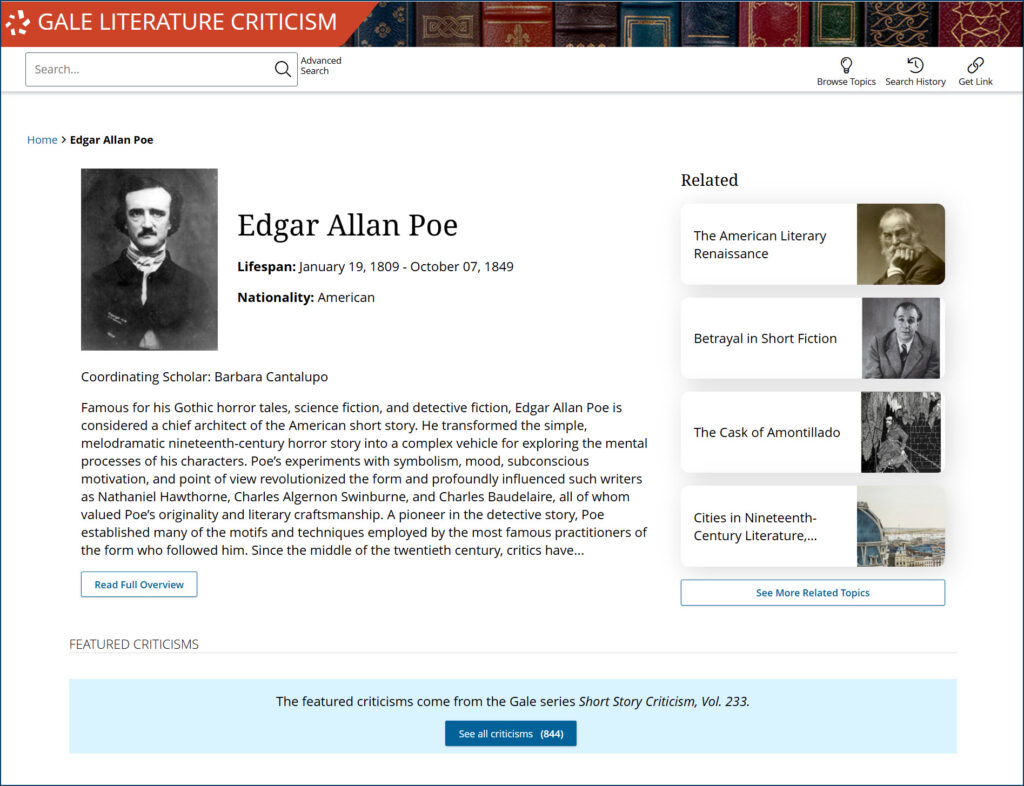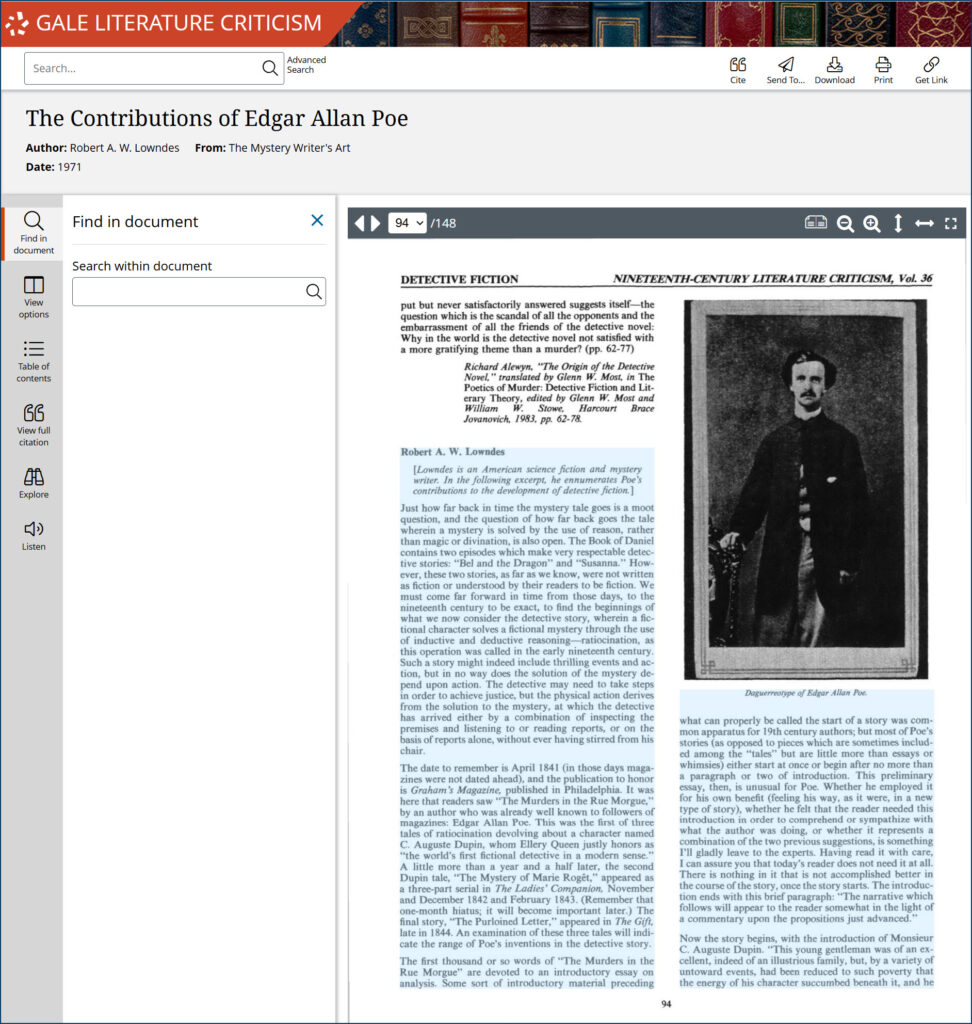| By Gale Staff |
Edgar Allan Poe’s morbid themes and unconventional life make him a fascinating figure. From compelling detective stories to macabre poems, Poe’s writing was a pioneering venture into the darker side of the human experience. Fear, mental duress, and death were all fair game.
Born on January 19, 1809, Poe’s early life was lonely and tragic. His mother died suddenly when Poe was just two. And while he had the opportunity to attend college, he struggled to pay tuition and amassed significant debt because of his gambling difficulties.
After dropping out of college, his life was marked by further setbacks. His fiancée left him for a wealthier man. He joined the army but was court-martialed soon afterward. Although he later married, his wife died at just 24 years old. Nonetheless, he continues to inspire readers and horror enthusiasts long after his own untimely death at just 40 years old. His gravesite in Baltimore attracts thousands of visitors yearly, and the city hosts an Edgar Allan Poe festival every fall.
It’s crucial that your campus library provide high-quality resources to support your students’ research. In lieu of expensive and bulky anthologies or textbooks, consider Gale Literature Criticism, an award-winning digital series that offers unparalleled access to centuries of literary analysis. The database’s Poe topic page—which includes peer-reviewed essays, biographical information, and a helpful synopsis of his major works—is a valuable addition to your library’s catalog.
With Gale, students can dig into Poe’s work, learn more about his inspirations, and see how his writing fits into (and influences) American romanticism, horror, and pop culture. Demystify one of the most intriguing authors in modern history with Gale’s user-friendly navigation tools and guided research.
Consider the Mystery Behind Poe’s “The Raven”
Poe’s most famous work, “The Raven,” uniquely captures his creative prowess. Published in 1845 in the New York Evening Mirror, the poem stands at just 108 lines and tells the story of lost love. Poe’s expert use of rhyme, repetition, and meter creates an eerie tone that garnered widespread recognition for the piece as a literary triumph and gothic masterpiece.
Gale houses an extensive collection of critical analyses exploring the poem’s nuances and possible sources of inspiration, giving students a window into how it was initially received alongside the current analyses of academic critics writing about the poem still today.
To assist students in narrowing down their search results, users can easily leverage Gale’s filtering tools. Find everything you need for a more in-depth study, whether exploring the poem’s potential racial undertones, shared themes with other well-known American works, or disregard for the established rules of Romantic poetry.
But what sparked the idea for “The Raven”in the first place? Gale Literature Criticism houses plenty of diverse opinions to consider. One possible source could be the German poem Lenore, by Gottfried August Bürger. Another critic suggests that “The Raven”comes from the Greek poem Anacreontea, and yet another argues that a Chinese poem from 100 B.C. shares an evident resemblance to Poe’s.
Perhaps Poe read “The Raven; or the Power of Conscience,” published anonymously in 1839. And, of course, it’s hard to ignore that Poe once met Charles Dickens, who famously had a pet raven named Grip. Whatever the truth, “The Raven”is a source of fascination for many, from established literary experts to curious college students.
Reflect on Poe’s Ongoing Impact on American Pop Culture
As magazines grew more popular among American readers in the mid-nineteenth century, Poe mastered the short-form publication, learning to captivate readers with just a few paragraphs. Many credit him with redefining the American short story. Despite his brief career, which nonetheless included more than 50 poems and dozens of stories, Poe would inspire several prominent authors, fundamentally changing the modern literary landscape. He and Nathaniel Hawthorne were known to correspond and review each other’s drafts. Charles Baudelaire adored Poe’s work and spent more than a decade translating it for French readers. Even Agatha Christie fell under Poe’s spell.
Poe’s influence on American detective fiction and the horror genre is undeniable. Most suggest that Poe’s roguish detective in the 1841 short story The Murders in the Rue Morgue is an obvious inspiration for Sir Arthur Conan Doyle’s Sherlock Holmes. H.P. Lovecraft, a well-known American horror writer, was equally enamored by Poe’s work. Popular media continues to reference Poe’s “The Raven,” appearing in episodes of The Simpsons and Gilmore Girls. Even Baltimore’s NFL team is aptly named the Ravens.
Poe is one of America’s most celebrated authors, and Gale Literature Criticism helps bring his stories to a new generation of readers. With helpful accessibility features such as customizable viewing options and text-to-speech audio, Gale products help you support your student’s learning needs while allowing space for independent study.
At Gale, we aspire to reduce barriers to academic achievement, including financial hurdles. We host an open-access portal for readers to find reliable, unbiased content on trending social issues, history, and—of course—popular literature, including an overview of Poe.
Literature is essential in helping people express their thoughts and better understand the world around them. To that end, our open-access literature portal provides academic articles, author biographies, and helpful literary overviews of popular works. After all, great literature and the ability to appreciate it should be available to everyone.
In honor of his birthday this January, take a moment to highlight his work and the related academic resources you host in your library. With Gale Literature Criticism and all Gale products, you can trust the quality of information available to your campus. Educators and students will benefit from our extensive digital collections for lesson planning and research activities regardless of the topic.
If your institution or library doesn’t subscribe to Gale resources, request a trial or contact your representative.



